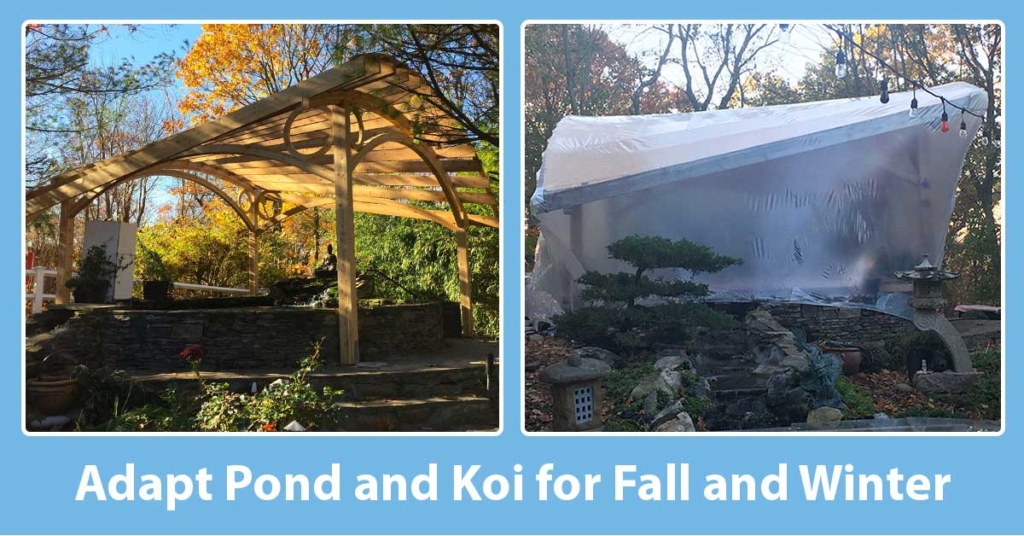
Summer is over. Fall has arrived, and winter pond care is quickly becoming a priority with snow in the forecast. As temperatures drop, koi pond winterization is crucial to prepare your beloved Koi stays healthy and safe.
For our beloved Koi, what should we do?
Tips on How to Look After Koi Fish and Pond during Winter
The following topics are important to know for Koi and Pond Care in Winter and will be covered in this article:
- Pond Water Temperature vs. Feeding
- Medicating the pond
- 4 pond housing options for fall and winter
- Winter pond prep Q&A
Quick Links on Pond In Winter Question
What steps should you take for proper winter pond preparation and care?
Best Winter Koi Pond Maintenance
Best practices for Koi Pond Winter Care
Pond Nets and Permeable Covers?
How to protect Koi Fish in freezing temperatures?
Koi Pond heating options for winter?
Pond in Winter Preparation Tips and Survival Guide
Fall (as well as spring) is a vulnerable time for Koi because water temperatures 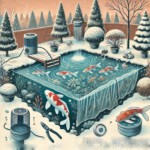 fluctuate and start dropping. If we do things wrong, our Koi may not endure the long winter and arrive in the spring unhealthy. So it is vital to prepare for Koi winter survival. Use this article to see our best tips and products for your pond in winter.
fluctuate and start dropping. If we do things wrong, our Koi may not endure the long winter and arrive in the spring unhealthy. So it is vital to prepare for Koi winter survival. Use this article to see our best tips and products for your pond in winter.
We will finish up by also covering some common questions about Koi winter prep in the Q&A section. Ask a question at the end of the article if you want to learn more. We also welcome you to explore more about our Koi for sale online.
Join Kodama Koi Newsletter
Get insider knowledge and sign up for our Kodama Koi newsletter to receive a free koi varieties poster! New subscribers will also receive a 10% off coupon for kodamakoisupply.com when joining.
Essential Pond Tasks to do in Winter. How to Winterize Pond for Fall and Winter.
There are several ways to winterize your pond and Koi. Depending on your pond situation, you may choose to keep your Koi in the pond, move some or all to an enclosed holding tank, or build a greenhouse around your pond. Cold weather koi pond maintenance and winter pond preparation for koi fish are essential steps in keeping your fish healthy through the colder months. These are the 4 winter Koi care methods we recommend for you to consider.
1. How to Prepare Koi Ponds for Winter
To ensure your koi’s health and safety during winter, especially in regions with snow and freezing temperatures, it’s important to maintain your pond properly. Follow these tips for effective pond management: winterize the pond which is crucial for your koi’s survival.
- Stop the Pond Water Pump and Filter. If you have multiple pumps, you may not have to stop them all, but make sure water does not move and push Koi too much. Let them hibernate calmly. If you stop filters, please drain all water. If you leave water in them, they will hold rotten, sludge water until spring. You do not want that water going back to your pond.
- Keep Pond Air Pump running. The air pump will keep a hole on the ice. It will de-gas your pond and also prevent ice to completely freeze your pond and for degassing.
- Maintaining the Right Pond Temperature during WInte. It’s crucial for the health of aquatic life. Use pond heaters in winter and shading or aeration in summer to prevent temperature extremes. Proper control ensures stable conditions, reduces stress on fish, and prevents diseases, promoting a healthy and balanced pond ecosystem.
Buy 1000 Watt Titanium Heater and Controller to read temperatures easily.
Buy Therma Koi Heater to warm your pond
Winter Koi Pond Water Temperature vs. Feeding
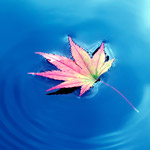 Understanding the importance of water temperature in winter pond management is crucial, yet it is often overlooked. Why monitoring water temperature is essential for Koi health becomes particularly evident in the spring and fall when temperatures fluctuate. Koi are cold-blooded, meaning they cannot control their body temperatures, which are instead regulated by their environment.
Understanding the importance of water temperature in winter pond management is crucial, yet it is often overlooked. Why monitoring water temperature is essential for Koi health becomes particularly evident in the spring and fall when temperatures fluctuate. Koi are cold-blooded, meaning they cannot control their body temperatures, which are instead regulated by their environment.
Best practices for koi pond winter survival include:
- Monitoring water temperature closely
- Adjusting feeding programs based on water temperature
- Protecting koi ponds from freezing temperatures
Tips to protect koi ponds from freezing temperatures include using a pond thermometer, adjusting feeding schedules, and taking steps to prevent ice from forming on the pond’s surface. By taking these steps, you can help keep your koi fish healthy and thriving during the winter months.
|
About 65–68 °F is the turning point.
Above is a chart of recommendations by Koi food brand (yellow boxes mean’s it is ok to use). |
The most common mistake I see is that owners feed as much as their Koi can eat even in the fall and winter. Owners think they are hungry because they ask for food. They may be eating, but it does not mean they can digest the food properly.
If you keep feeding them when they cannot digest, these kois will die by or in spring because of poor digestion.
It may look harsh not feeding your Koi for as long as 6 months (depending on where you live), but it is much safer for them. So at optimum water temperature ranges, ensure you feed your Koi as much as possible. That helps your Koi build their bodies’ reserves for winter. Feed as much healthy food as you can (like KKF Wheat Germ All Season) while they can both eat and digest it. We highly recommend you purchase a pond thermometer so that you can better keep track of your temperature.
2. Move koi to a holding tank inside an enclosed space
Once Koi enter hibernation, especially underneath ice, you have no idea what is happening below. Sometimes this is not realistic if you have a large amount of Koi in your pond. Time to think like local interior designers and find a beautiful place for your koi’s indoor home For piece of mind, it is a good idea to set up a holding tank in a garage ideally with a Koi heater. You can learn how to create a Koi quarantine tank in this article.
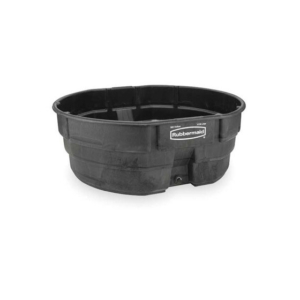
Protect Your Koi with the Right Koi Tank Setup!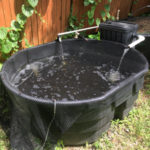
Are you introducing new Koi to your pond or managing their health during winter? Our comprehensive guide covers everything you need to know about setting up a quarantine tank, ensuring your Koi stay healthy year-round. Learn how to prevent disease and maintain a thriving pond, even in colder months.
Don’t take chances with your Koi’s well-being.
Read guide and provide the best care for your fish!
3. How to Build a Greenhouse to Cover Your Koi Pond
Protecting Your Koi Pond in Winter is crucial to maintaining the health and safety of your fish. One effective method is to build a greenhouse to cover your pond during the colder months. You can either buy a small greenhouse kit specifically designed for Koi ponds or construct a custom frame using PVC or wood and cover it with a plastic sheet. This setup helps prevent your pond from freezing over and maintains a stable environment for your Koi.
By using this method, you can easily access your pond to monitor your Koi regularly. For an even more effective setup, consider installing a Koi pond heater within the greenhouse. This allows you to maintain a year-round habitat similar to summer conditions, ensuring your Koi continue to thrive.
Secure the plastic sheet over your pond frame by anchoring it with heavy objects around the perimeter. In the photos below, you can see an example of a DIY frame constructed by one of our customers. This frame serves a dual purpose, offering both shade in the summer and support for a winter cover. With a bit of creativity, you can build a greenhouse for your Koi pond that retains warm air, keeping your Koi comfortable all winter long. Don’t overlook the benefits of adding a Koi pond heater to your greenhouse setup!
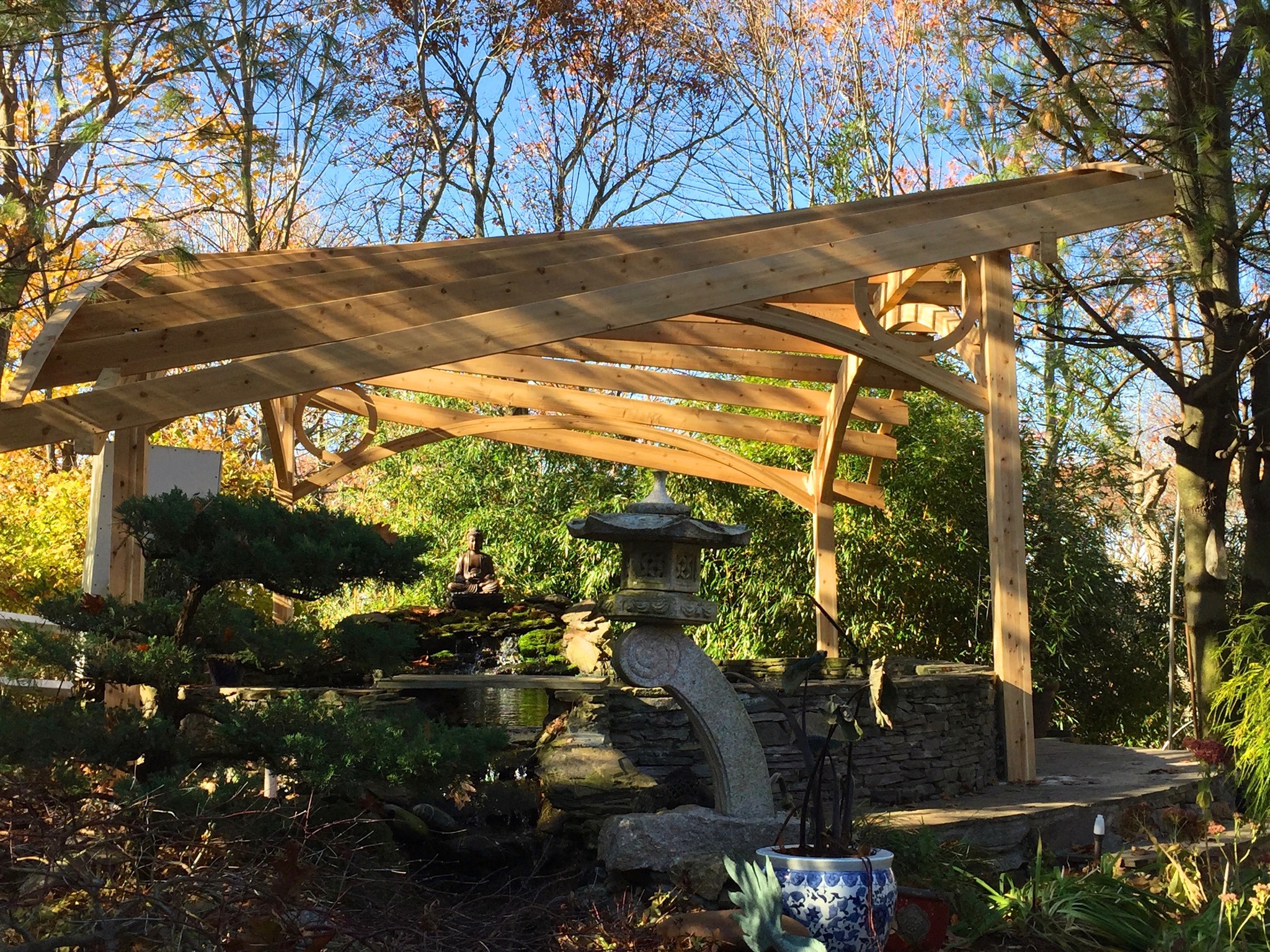
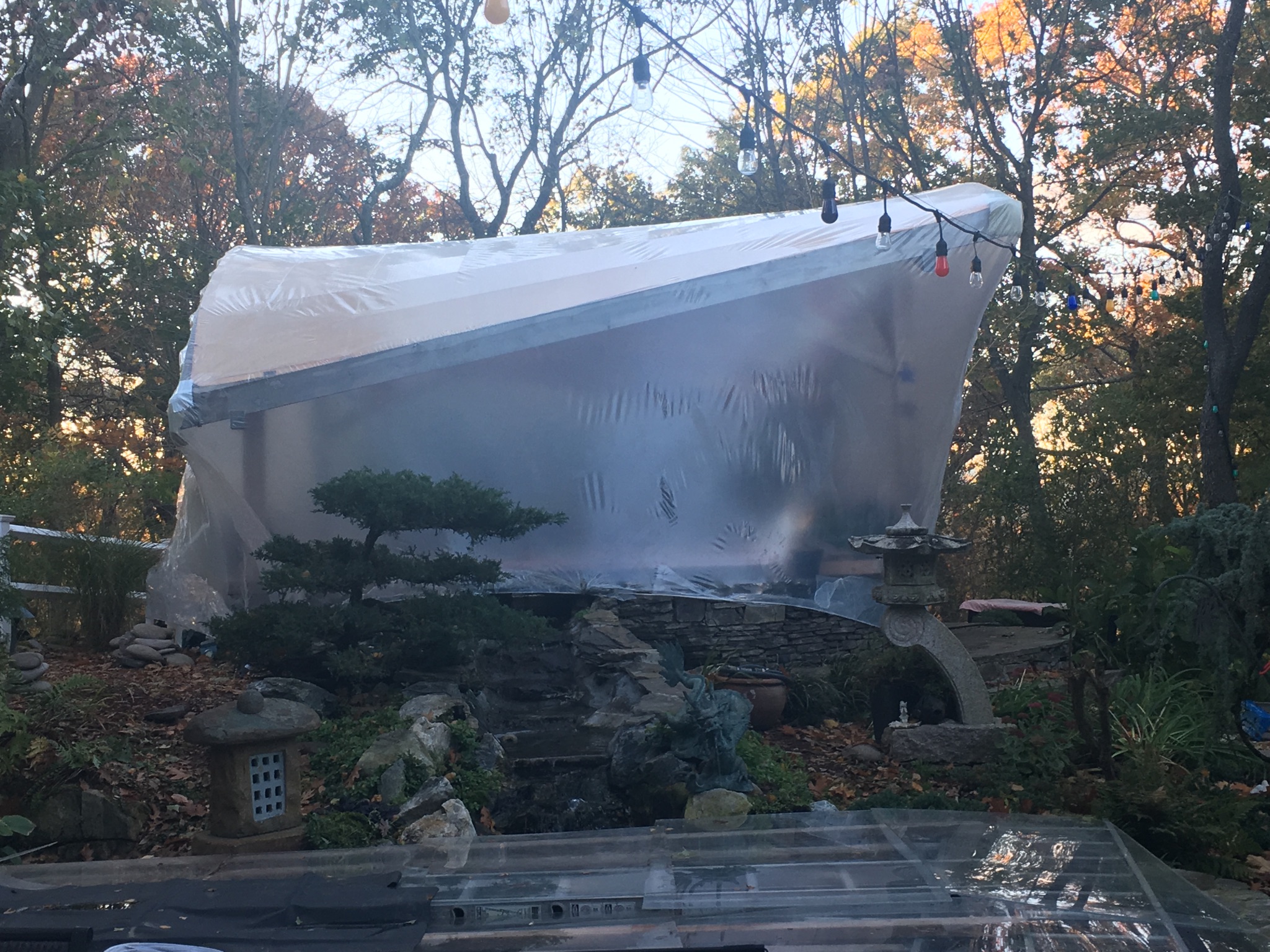
4. Cover your pond with solar cover used for pools
- Start by laying rocks, pipes, or lumbers such as 4”x 4” across the pond in 1-2 feet apart.
- Then, put solar cover over being held down by the weighted objects.
- Ensure the entire pond is covered.
- Keep your air pump running to de-gas and prevent pond from completely freezing.
Example of Koi Pond Cover in Winter
There are many options for setting up your pond for the Winter months. We find the design of this pond cover for winter to be especially beautiful and proud to say they are also a Kodama Koi Farm customer. When you want to decide how you will take care of your pond fish in Winter, you will have the following options to consider:
- Keep your koi in the pond for Winter
- Move koi to a holding tank inside a garage or enclosed space
- Build a greenhouse to cover your pond
- Cover your pond with solar cover used for pools
The below example is a greenhouse built to cover the entire pond in Winter.
5. Koi Pond in Winter & Medication
Prepare for the Worst with Proper Pond Care in Winter
To ensure your koi pond thrives during the cold winter months, it’s essential to take proactive steps. One crucial practice is to medicate the entire pond twice a year, once in the spring and once in the fall.
Protect Your Koi from Parasites
As water temperatures drop, your koi become more vulnerable to parasites. Before the winter chill sets in, make sure to treat your pond to eliminate any parasites that may be present. We recommend using the following two products to help your pond and koi have a successful winter:
By taking these precautions, you’ll be well-prepared to face the challenges of winter and keep your koi pond healthy and thriving.
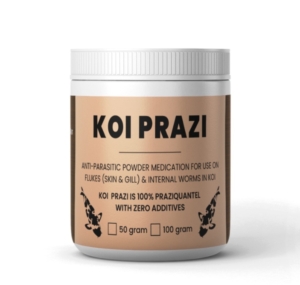 Buy Koi Prazi for preventing parasitic flukes
Buy Koi Prazi for preventing parasitic flukes
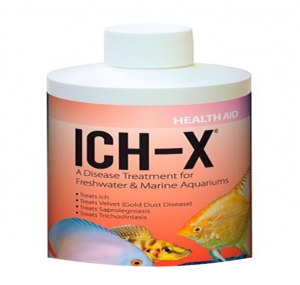 Buy Ich-X Water Treatment for treating parasites
Buy Ich-X Water Treatment for treating parasites
Year-Round Koi Care Starts Here!
No matter the season, ensure your pond is always a safe haven for your koi. Visit Kodama Koi Supply for seasonal pond care essentials. If your koi show signs of illness, check out Kodama Koi Farm’s health diagnosis guide for expert advice on keeping them healthy all year round.
Kodama Recommended Products
- 300 Gal. Tank
- Therma Koi Heater
- 1000 Watt Titanium Heater and Controller
- Manda Fu Food
- Water Filter
- Pond Thermometer
- Koi Prazi
- Ich-X water treatment or a similar product such as Terminate.
- Make your own medicated food with antibiotics
Good Luck in your Winter Pond Care!
Comment below if you have any more questions.
Winter pond care is all about ensuring a healthy start to the next season, so take the time and make sure you are providing an environment that fosters a strong immune system to benefit you and your Koi.
Remember that an ounce of prevention is worth a pound of cure!
Discover how to prepare your koi pond as winter turns to spring properly.

Q&A to Prepare Koi Pond for Winter Survival
Learn from Taro Kodama as he explains further on how to create a winter pond where your Koi will survive the cold. Use the tips in this guide to care for your Koi through the fall and winter.
Can koi fish survive winter in outdoor pond?
Yes, they are able to survive. Follow the directions above in this article to winterize your pond.
Should I stop pond waterfall during winter?
Yes. even if you put up a greenhouse, the waterfall will expose water to cold air and chill your pond water. We recommend you stop or bypass the waterfall for your pond during the winter.
How deep should a koi pond be for winter?
The deeper the Koi pond is, the better, especially where it freezes. Five feet ideally is what to shoot for, but I know customers who have only 3 feet and do ok with Koi winter survival.
Should I drain my pond in the winter?
If Koi are relocated to an indoor tank or a different tank, then I don’t think the pond needs to be drained. In spring before you move Koi back, the pond should be drained for the new season.
Can koi fish freeze and live?
If a Koi is frozen in ice, then it will not survive the winter. Using winter Koi care, you will prevent your Koi pond from freezing the Koi; and thus they will survive the winter. We recommend using a Koi heater if you are in a cold environment.
Should I cover my pond in winter?
It is recommended that you cover your Koi pond in the winter to keep the water warm and keep leaves/debris off the pond. There are 3 recommended models you should follow for your pond in winter.
Do koi fish eat in the winter?
Koi can eat in the winter, but cannot digest food. So when it is under 50° F, we should NOT feed Koi. With Manda Fu Koi food, you are able to feed Koi fish down to 45° F.
Do koi grow in the winter?
If the Koi do not eat, then they do not grow. We recommend using Manda Fu in the fall / winter months due to its increased digestibility.

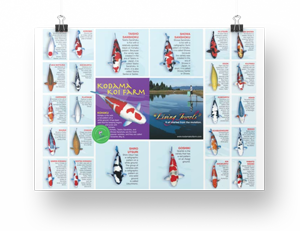
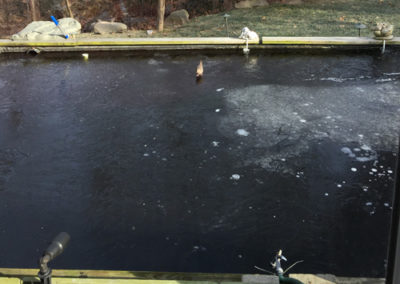
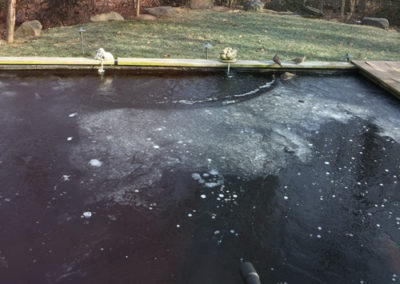
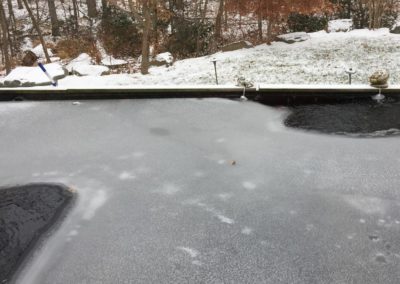
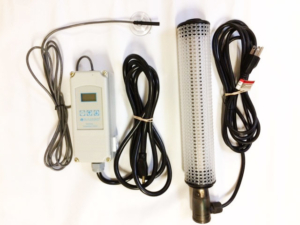
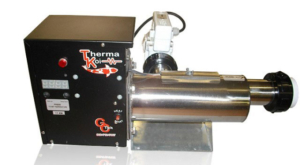

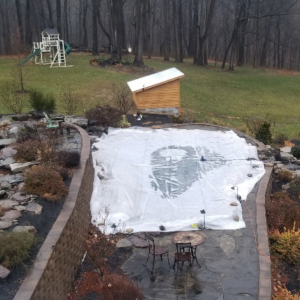
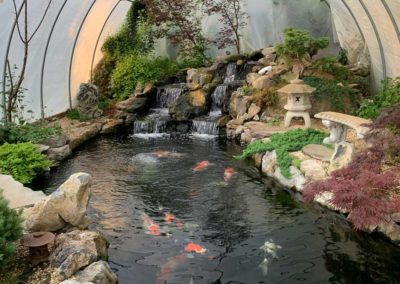
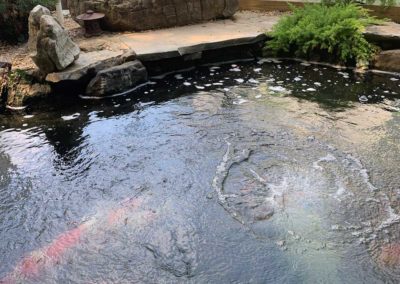
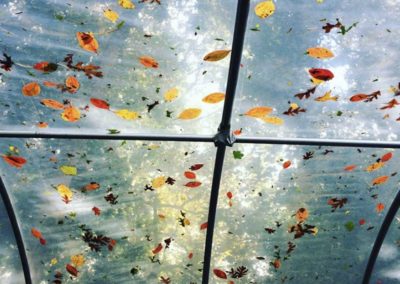
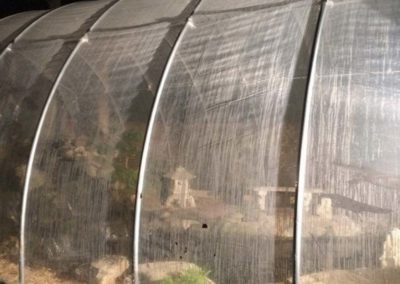

Thank you for taking the time to publish this article I am sure it will be very helpful to some. I have a 2500 gal pond that is 3′ at the deep end I lay pipes spaced about a foot apart over the pond and about 1′ above the water surface and very little sun hits my pond in the winter an it usually will not freeze over as long as the edges of the plastic are held down with rocks. I live in Pa where it can get down to zero degrees. I think this is very important and also get all the leaves out before hard winter sets in.
Mr. James,
Thank you so much for sharing your methods. I am sure it is helpful for the others too.
I have 4 6-8″ koi that remained when I got rid of my large pond. I would love to keep them. They have spent the past year in a horse trough with greens, not being fed. I will need to ship them from Carmel, California to Charlottesville, Virginia. I can have them in an indoor aquarium or plan for something on a deck. I need help. I hate to leave or lose them.
Hello
So you need to know how to transport your koi?
Do you still need to rehome them
I bought two 3 inch Chinese HiFin Banded Sharks for my 4000gal pond. They are supposed to be great algae eaters. They survived through our relatively mild Winter here in eastern Washington State until late January. I don’t see them now. If they have died, I suspect it’s because of the lack of algae in the pond and not cold water. Of course I don’t feed the koi when water temps fall below 50 degrees.
What are your thoughts about the Chinese fish and their probable demise?
I am very sorry. I do not know much about these fish.
Our Koi are in a natural pond with frogs, leeches, and insects. We can stop them from eatting in winter and the pond is too big to cover or catch them We live in Canada, any tip for over wintering?
Hi
I have never herd of ich-X before
I’m curious can this be used with sensitive species? Sturgeon ?
I have a Koi pond that is 38” deep. We do minimal for our pond in the winter here in Colorado where it can get to -20^.
I typically run air pumps to add air to the water and I keep my main waterfall running to ensure adequate aeration. It will usually freeze completely over the waterfall during Jan-feb but otherwise runs continuously. My Koi – 10” – 28” have done quite well during the winter hibernating on the bottom for the last 10-12 years. I do not feed the fish during the winter, if they need food they can find adequate supplies in the pond itself.
Thanks for the site, it is very informative.
Great practice. Thank you for reading our blog and leaving your comments.
I live in Colorado at close to 8000′ above sea level. I have a pond, just built this year, with a skimmer and a waterfall that is around 4000 gallons. We have 12 goldfish living in it and will overwinter. I keep getting conflicting information; I prepped the pond for winter by removing the pump and shutting down the skimmer and waterfall. I dropped the water level below the skimmer opening and installed an aerator for a 5000 gallon pond. Trimmed and sunk below what I hope to be ice level. But, my pond has completely frozen over and it’s only December. I called the aerator company and they state that the waterfall and skimmer should be left on year round! I do NOT know what to do- the pond is frozen so I can’t really start the waterfall again and there is BIG concern that the pump and water lines will freeze. Also, concerned with depth of ice and if the fish will survive (we already have dead frogs and that’s another challenge to figure out) and we dug it about two feet deeper than the pond kit company said it needed to be; thank goodness since we had to drop it a foot to get below the skimmer opening. I am at a loss of what to do and any recommendations or ideas would be GREATLY appreciated. TIA!
Hi Laura, I have had koi pond for very twenty years in Missouri.I shut my waterfall down when it got below 40, kept the aerator going and put two tank warmer’s in so as to if it was below freezing they would kick on.I never had a problem as long as there were place on the pond that didn’t freeze over from the tank warmer’s. I now live in Florida and brought some of my koi with me. I hope I was of some help.
Once last thing to my massive post- the aerator company said that the ammonia levels and such from the fish would build up and kill the fish if the skimmer/filtration was turned off… HELP! TIA 🙂
I am very sorry for the late reply. It is probably the best to contact your local pond person. If you live in Colorado, try professional Ponds ( https://www.professionalponds.com/ )
Hello there, BR&D Landscape offers excellent pond design, construction, and maintenance. We serve commercial and residential clients in Denver, Colorado Springs, and Front Range communities. Check out website https://brdlandscape.com/
Hello I inherited a very large KOI pond its about 15 ft x4 ft..with about 30-40 fish! How do you inherit a KOI pond, well the previous home owner lived until he was 97, and passed away. I bought his house including the ponds. I am a single mom..my kids just left the nest last year..and I am an animal lover. I hope I do right by these fish but I am probably going to need tons of learning and help!
Koi is a great hobby and I am sure you enjoy them. If there are any we can help you, simply email us at info@kodamakoifarm.com
I have a 14×20 pond 2.5 deep in the deep end. I usually run the pump all winter with a 2500 watt tank heater in the deep end and 3 or 4 air stones to keep holes open.Which has worked well in the past. my new quandary is my frog has taken to hibernate in my bio falls,
do you think he will survive the winter there? I have a 2 1/2 inch insulation over the top.
do you think he will surviveGeorgeG there ?
Hello, I am sorry I am not really familiar with frog hibernation. I assume if the environment is good for Koi, it should for frogs, too. But I am not sure. Can anybody answer?
I have lots of Frogs. Which = tadpoles = food. After the ice melts & temperatures with sunny days warm the banks. The frogs & tadpoles appear, about 5 warm days (50’s) later my fish will swim to the banks & start chowing down. They must wake up to eat?
I have secured tarpaulin sheets onto my pergola, all the way round, to keep the cold easterly winds at bay. Currently i have a pond water temp of 4.1c, i hope tonights forecast of -11c doesnt have an adverse effect.
My wife and I live in north central Florida.
Our pond is 7 ft deep.
They were 8 to 10 inches long when they went dormant.
We have yet to see them this year ?
All the bluegills,brim we are seeing.
But yet no catfish or koi.
Any ideas ?
Thanks for sharing this! I was really worried about my Pond coming into the winter season. The contractor of pond kits near me here in Colorado, also gave some great advise so I was able to winterize my Pond. Thanks to you guys and my contractor!
Can you please let me know why one of my large Koi has appeared at the surface of the water. Is he at the end of his life – can I do anything to help him?
This can happen due to a number of reasons. Please send our customer service team a picture/ video by email and we can further help.
info@kodamakoifarm.com
This may sound silly, but it has worked for 9 out of 11 fish over the years. I have about 30 fish in my pond, ranging from 6″ to 20″ goldfish & koi. When i see any of my fish start to float on their side or belly up, i get a piece of netting about the size of the fish & fill a tank that the fish will fit in, & i wrap the netting underneath the fish like a sling. The fis has to be snug enough to hold the weak fish in one position (right side up), but loose enough for the fish to wiggle out of when & if he gathers his strenth. The i put the fish in the tank next to the glass & clip the top of the sling with clothes pins to the top of the tank. The tank has to be filled to the top so it covers the snugly wraped fish. Keep an eye on it for a couple days. If it looks like he is turning over, straighten him out & re clip it. This gives them time to build up their strenth, instead of struggling to keep from dying. Like i said, it has worked with 9 out of 11 fish ive done this way. I know it sound ridiculous, but it works.
Thanks for sharing that sling method. I have had several fish with swim bladder issues, have given magnesium salt baths and held them upright for a brief periods, but no successful cures. Will give it a try.
I’m not sure if I should feed my Koi Hikari wheat germ in the temperature fluctuating from 50 to 70 degrees in Charlotte N.C. for about couple of weeks now. The Kois are so active and I’m very attempted to feed them. What do you recommend and is it ok to feed them in mild Winter temperature? Thanks in advance and I look forward to hearing from you soon.
Hi
It is ok to feed them if the temperature is over 55 degrees, please see our kodama blog post on getting koi ready for winter.
Hello! Very informative site. Thank you for sharing your knowledge. My question is: I have approximately 50 fish in a 16’x20′ pond that is approximately 4.5′ deep. I have lots of filtration, air pumps, and water flow going due to accommodating the overload of koi. The temperatures have dropped to 20 degrees here in the Midwest, and I am fearful to turn all those devices off because of the overload becoming toxic at the bottom of the pond due to waste from the fish and other organic material that may not have filtered out and has now settled on the bottom of the pond (leaves, sticks, etc). Just this week I had two fish come to the top either upside down or on their sides. I have since put them in a quarantine tank and as of today they are doing somewhat better with treatment. Is it really okay to turn everything off except the air pumps that will leave a hole in the ice? Just really scary for me to just turn it all off.
I have a few koi and enjoy them but I don’t become attached to animals so to do away with the headache, heartache, and back ache every winter, I donate them back, before “the freeze”, to the place I bought them. So basically, I’m “renting koi”. It’s worth it to me to just pay the price of the koi each Spring and to know that the fish I enjoyed during the nice weather will be well taken care of in the winter.
Hi I’m Mike and I live in queens nyc. I just moved into my new home a month ago. I’ve been briefed by the old home owner who took great care of his pond, and I would like to do the same. I’m a novice at kois. But pretty decent with fresh water 55 gallon fish tanks. I would greatly appreciate any tips and advice. But two questions I do have is. When should I turn on my filter? Cause I’ve seen close 70 degree days and currently we are at 49 degrees. And two, how do I go about adding bacteria to it? The old home owner left me with a 1 gallon jug of ‘pond microbe-lift’ ‘PL natural safe & beneficial bacteria? With filter off? Or on? These sort of tips would be great. I really don’t want to kill these fish. It’s been a dream since I was a kid to have kois. Never thought I’d actually get them. It’s 3,000 gallon pond. Rough dimensions are 10 feet wide x 18 feet long. And the owner said 3 1/2 feet deep roughly. Thankyou for any advice. And sorry for ranting.
Hello, I am not sure what type of filters you have, but if the water temp is 49f, I think you can start the filter. Please make sure there is no old and rotten sludges left in the filter and that they will not come to water when you turn on. About the bacteria, if water temp is stable around 50-55, I please add it to your pond.
We also have a retail store, Kodama Koi Garden on the long Island. Please pay a visit so we can assist you better.
https://www.kodamakoigarden.com/new-york-koi-pond-supply-store/